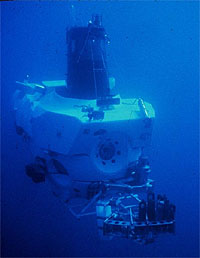Russian mini-sub descend toward seabed under North Pole
One of Russia's two deep-diving miniature submarines on Thursday began its descent more than 2Ѕ miles (4 kilometers) beneath the ice to the ocean floor beneath the North Pole, RTR television reported.

During what the expedition leaders describe as a perilous dive, crew members planned to drop a titanium capsule containing the nation's flag on the bottom, symbolically claiming almost half of the planet's northern polar region for Moscow.
In a feat mixing science, exploration and the scramble for potential oil and gas fields, the sub crews are attempting what Russian authorities called the first dive to the ocean floor at Earth's northernmost point.
Two MIR subs and their three-member crews planned to spend several hours in the murky depths conducting a close-up survey of the geologic structure of the seabed at the pole, according to Russia's Institute of the Arctic and Antarctic, which organized the expedition. The operation, which reportedly began about 0530GMT, was expected to take eight hours.
"I am scared and I don't hide it," said Artur Chilingarov, 68, the famed polar scientist leading the expedition, in comments broadcast on Russia's NTV television before he boarded the first sub to descend. But he said he had confidence in the support team aboard the research ship Akademik Fyodorov.
Later, Chilingarov was shown on Russia's Channel One reassuring his fellow expedition members. "We'll be back, and we'll embrace you," he said.
The subs, two of only five manned submersibles in the world that can dive beyond 3,000 meters (9,840 feet), are expected to return to the surface and the Akademik Fyodorov at 1200 GMT.
Expedition members say the biggest challenge for the sub crews will be to find their way back to an opening in the surface of the 1.5 meter (5 foot) thick polar pack ice after their dive. They must resurface before exhausting their air supplies.
Researchers mapped the location of the natural openings in the ice before the dives. The atomic-powered icebreaker Rossiya spent most of Wednesday night and Thursday morning carving a 125-by-10 meter (410 foot by 33 foot) artificial opening near the pole, RTR television reported.
U.S. State Department spokeswoman Leslie Phillips said, "We wish the Russian scientists a safe expedition."
Expedition scientists planned to map part of the Lomonosov ridge, a 1,240-mile (1,995-kilometer) underwater mountain range that crosses the polar region. The ridge was discovered by the Soviets in 1948 and named after a famed 18th-century Russian scientist, Mikhail Lomonosov.
Subscribe to Pravda.Ru Telegram channel, Facebook, RSS!


